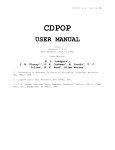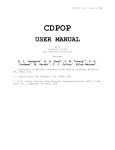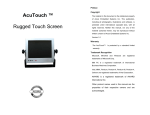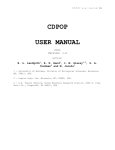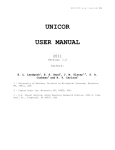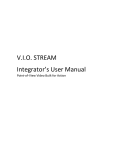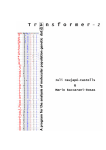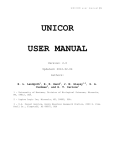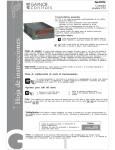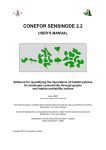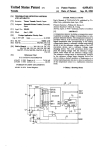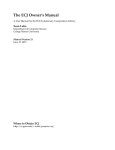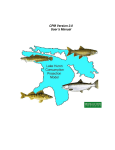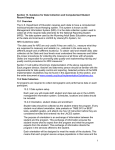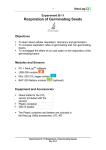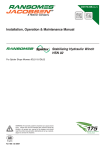Download CDFISH user manual - Computational Ecology Laboratory
Transcript
CDFISH user manual |1
CDFISH
USER MANUAL
2012
Version: 0.55
Last Updated: 2013.10.08
Authors:
Erin L. Landguth1, Clint C. Muhlfeld2, and Gordon
Luikart3
1 - University of Montana, Division of Biological Sciences, Missoula,
MT, 59812, USA.
2 - U.S. Geological Survey, Northern Rocky Mountain Science Center,
Glacier National Park, West Glacier, MT, 59936, USA.
3 - Univeristy of Montana, Flathead Lake Biological Station, Division
of Biological Sciences, University of Montana, Polson, MT 59860, USA.
CDFISH user manual |2
Table of Contents
1
2
3
4
5
6
7
Introduction.................................................. 3
1.1 Changes from CDPOP.................................... 3
1.2 What can CDFISH do.................................... 3
1.3 How does CDFISH work.................................. 3
Getting started............................................... 5
2.1 Dependencies.......................................... 5
2.1.1 Baseline requirements............................ 5
2.1.2 Python on non-windows platforms.................. 5
2.1.3 Python on windows................................ 6
2.1.4 Obtaining NumPy.................................. 6
2.2 Installation.......................................... 6
2.2.1 Installing Python and NumPy...................... 6
2.2.2 Installing CDFISH................................ 6
2.2.3 Description of CDFISH files..................... 7
2.3 Example run........................................... 7
2.3.1 Command line run................................. 7
2.3.2 GUI run.......................................... 8
Input......................................................... 9
3.1 Input Files........................................... 9
3.2 Model Parameters...................................... 10
3.3 Mating Parameters..................................... 10
3.4 Dispersal Parameters.................................. 11
3.5 Offspring Parameters.................................. 11
3.6 Genetic Parameters.................................... 12
Output........................................................ 12
General issues................................................ 12
5.1 How to obtain CDFISH.................................. 12
5.2 Debugging and troubleshooting......................... 12
5.3 How to cite CDFISH.................................... 12
5.4 Disclaimer............................................ 13
References.................................................... 13
Acknowledgements.............................................. 15
CDFISH user manual |3
1
Introduction
The goal of this user manual is to explain the technical aspects of
the current release of the CDFISH program (v0.5). The program is
written in Python 2.7 and provided with installation instructions for
most platforms, along with sample input files. CDFISH v0.5 is built
on a driver-module, plug-in, docking architecture that allows for ease
of future modular development. CDFISH has been debugged as carefully
as possible by testing all combinations of simulation options.
Information for users, including this user manual, FAQ, publications,
ongoing research, developer involvement, and downloads can be found at
http://cel.dbs.umt.edu/software/CDFISH/.
1.1
Changes from CDPOP v1.0
There are major innovations in CDFISH which were not included in
CDPOP. We list below the new functionalities of CDFISH:
1.2
Subpopulations of individuals. Individual (x,y) locations can
now be grouped into subpopulations on the landscape that could
represent home spawning grounds, for example.
Population dynamics. Subpopulation numbers can now fluctuate as
a function of vital dynamics, straying, and/or the inability of
an individual to make it back to its original subpopulation.
Offspring have 4 states: residency, migration, straying, or
death. With residency, offspring do not disperse back to the
source location (lake or ocean, for example), but reside in their
original subpopulation. Migration is a probability of returning
back to a subpopulation that is a function of the stream
resistance surface (in units of cost). If an offspring does not
migrate back to its original subpopulation than it can either
stray to another subpopulation at some probability or die.
What can CDFISH do
CDFISH’s realistic representation of the spatial environment and population genetic processes provide a powerful framework to investigate
the impact of ecological factors on the genetic structure of aquatic
species. Example simulations might include:
1.3
How will changing stream resistant surfaces affect the genetic
structure from an individual-based setting?
What combinations of probabilities of straying, migration, residency, and vital dynamics prevent a subpopulation from becoming
extinct?
How will the incorporation of a partial barrier on the stream resistant landscape affect the genetic structure and population dynamics of individuals or populations?
How does CDFISH work
CDFISH user manual |4
Individual-based simulations in riverscapes. CDFISH models genetic
exchange for a given stream resistance surface and n – (x, y) located
individuals as functions of individual-based movement through mating
and dispersal, vital dynamics, and mutation. Prior to running CDFISH,
users must create a stream resistance surface where each cell value
(pixel) represents the unit cost of crossing each location. Pixels
are given weights or ‘resistance values’ reflecting the presumed
influence of each variable to movement or connectivity of the species
in question (e.g., Dunning et al. 1992; Cushman et al. 2006; Spear et
al. 2010). Stream resistance surfaces can be parameterized to reflect
different costs to movement associated with water temperature and
flow, habitat complexity, barriers, elevation, slope, or other stream
features. From here, CDFISH requires as input a matrix of movement
costs that can be computed based on shortest cost paths algorithms
between all pairs of individuals (or populations). Common approaches
to calculating cost distance matrices in landscape genetics include
Dijkstra’s algorithm (Dijkstra 1959; e.g., implemented through
programs such as UNICOR (Landguth et al. submitted)), CIRCUITSCAPE
(McRae and Beier 2007), PATHMATRIX (Ray 2005), and COSTDISTANCE in
ArcGIS (ESRI Corp., Redlands, CA). By comparing genetic distances
between individuals with ecological cost distances between them,
researchers can test specific hypotheses about the influences of
stream features and environmental conditions on gene flow (Cushman et
al. 2006, Epps et al. 2007). The program can flexibly incorporate
absolute or partial barriers, and panmixia within this cost distance
modeling framework. This is critical to provide a consistent and
comparable framework to evaluate the pattern-process relationships
resulting from isolation by resistance, isolation by Euclidean
distance, and isolation by barriers (Cushman and Landguth 2010).
Demographics within subpopulations. Individuals are assumed to occupy
subpopulations on the landscape that is user defined by the (x,y)
locations. The simulation program assumes a carrying capacity within
each subpopulation and allows for varying population numbers through
vital dynamics (birth and death rates), offspring straying to another
subpopulation, and/or the inability of an offspring to make it back to
its original subpopulation due to a high stream resistance. The
genotype of each locus for each individual is initialized randomly
(i.e., maximum allelic diversity). The initial age structure of the
population and the sex of each initial individual is user defined.
Reproduction is heterosexual with a random mating structure. Mated
pairs can be chosen based on male or female with or without
replacement. Each mated pair can have a number of offspring that is a
bounded random draw based on a uniform probability distribution, a
Poisson draw with specified mean, or a constant number. Mendelian
inheritance with k-allele mutation (rate chosen by the user) is used
to generate the offspring’s genotype and the sex assignment is random.
Dispersal through residency, straying, and migration. Offspring can
either reside in each subpopulation (e.g., stream or tributary) or
CDFISH user manual |5
disperse to a source location (e.g., lake, river, or ocean).
Offspring that disperse to the source must migrate back to their
respective subpopulation or stray to another subpopulation. Straying
and residency probabilities are user defined for each subpopulation.
Migration to subpopulations is a linear function of the stream
resistant riverscape. Individual offspring move a distance from their
source location based on a random draw from a probability distribution
inversely proportional to a linear function; probabilities range from
one at no distance from the original location to zero at the maximum
dispersal distance.
To realistically reflect species-specific
dispersal abilities, the user specifies the maximum dispersal distance
(in cost units) an individual can travel, expressed as the maximum
path length for a species given its dispersal ability.
Simulating natural selection. Past versions of CDFISH modeled three
sources of genetic variation: gene flow, genetic drift, and mutation.
These versions assumed that different genotypes have an equal
probability of surviving and passing on their alleles to future
generations and thus, natural selection was not operating. CDFISH V
0.55 and greater implements natural selection analogously to the
adaptive or fitness landscape of allele frequencies (Wright 1932).
This new functionality enables extension of landscape genetic analyses
to explicitly investigate the links between gene flow and selection in
complex landscapes at an individual’s level. The user specifies
fitness landscape surfaces for each genotype of a single diallelic
locus that is under selection. For example, three relative fitness
surfaces must be specified for the three genotypes, AA, Aa, and aa,
from the two alleles, A and a. Selection is implemented through
differential survival of dispersing individuals as a function of the
relative fitness at the location on that surface where the dispersing
individual settles. CDFISH reads and extracts genotype and location
specific fitness values for each n – (x, y) individual in the preprocessing step. The program will continue all other processes the
same as above, with an additional step implementing selection during
the dispersal process.
CDFISH Input. A user must specify the input parameters through an
input script file or a graphical user interface (GUI). As the model
simulates stochastic processes, most applications will quantify mean
and variability of genetic structure across many runs. Thus, a Monte
Carlo option is provided for the user to choose the number of runs to
simulate given a single set of input parameters. In addition, a user
may also frequently wish to launch several runs with different
parameter values simultaneously (i.e., sensitivity analysis). This
functionality is provided through batch capability. See Section 3 for
program input details.
CDFISH Output. There are two model outputs. The first is a series of
coma delimited files specifying the locations, genotypes, age, and sex
of each individual at specified simulation years. The second output is
a file containing yearly values for various population parameters,
formatted to facilitate graphical display. See Section 4 for program
CDFISH user manual |6
output details.
2
2.1
Getting started
Dependencies
2.1.1 Baseline Requirements
CDFISH requires the Python2.7.x interpreter and NumPy package.
Remember that Python modules usually require particular Python
interpreters, so be sure the version ID for any external Python module
or package (e.g. NumPy or others) matches the version of your Python
interpreter (normally v2.7.x).
2.1.2 Python on Non-Windows Platforms
Some common computer platforms come with Python installed. These
include MAC OS X and most Linux distributions. To determine which
Python a MAC or Linux workstation has installed, start a terminal
console and enter “python.” You'll see the version number on the top
line (enter Control-D to exit). Replacing an older Python interpreter
(pre v2.4) with a newer one (v.2.7.x) on a Linux or MAC OS X machine
can be tricky, so ask a System Administrator for help if you’re not
sure which packages depend on the current Python installed.
2.1.3 Python on Windows
Windows (7, XP, 2000, Server) does not come with Python installed, so
follow the instructions below to obtain and install Python on a
computer running the Windows operating system. Get a windows
installation of the base Python installation (current v.2.7.x) at:
http://www.python.org/download/releases/.
2.1.4 Obtaining NumPy
A good suggestion for all-in-one installations is through the
superpack Windows installer available from the SourceForge website:
http://sourceforge.net/project/. Note that more complete information
for NumPy is available at www.scipy.org, where the SciPy module is
also presented. Another source is
http://www.enthought.com/products/epd.php for a free academic and
educational usage in a single downloadable installer that has
everything and then some (Numpy, Scipy, Matplotlib, and 70+ modules
for python). We highly recommend this version for easy installs.
2.2
Installation
2.2.1 Install Python and NumPy
Make sure that Python and NumPy are installed, and available to you.
You can test this by typing "python" at a command window. If python
is available you'll get the python prompt ">>>". If it is not a
recognized command, it means either that python is installed but is
not in your command shell's paths, or that python is not installed.
In the first case ask an administrator to add it to your command
paths. If your shell locates and loads python, type, "import numpy".
If python does not complain that there are no such modules, all is
CDFISH user manual |7
well.
The following instructions assume Python and NumPy are not yet
available on your computer; if they are, skip to section 2.2.2.
* First run the Python executable installer you've chosen, accepting
defaults for the installation directory. On Windows this will
typically place the executables and libraries in c:/Python2.7/bin and
the "site-packages" package tree for user installed Python modules in
c:/Python2.7/lib/site-packages. If you are installing it on a network
on which you do not have administrative privileges, you may need to
ask a system administrator to install python and the NumPy packages in
their default locations.
* Next install NumPy using the supplied executable installer. This
will install NumPy in your Python ./site-packages directory. If you
downloaded enthought’s version, you will not need to install a
separate NumPy installer.
2.2.2 Installing CDFISH (for Linux or Windows)
Next, install the CDPOP software itself by unpacking the zip archive
supplied. Navigate to the directory on your PC where you wish to
install CDFISH, and unpack the supplied zip archive file using a free
archive tool like 7Zip (7z.exe), Pkunzip, Unzip, or an equivalent.
Seven-Zip (7Z.exe) is highly recommended since it can handle all
common formats on Windows, MAC OS X and Linux. On Windows, it is best
to setup a project specific modeling subdirectory to perform your
simulations outside of any folder that has spaces in its name (like
“My Documents”). At this point you should be able to execute the
supplied test inputs.
2.2.3 Description of CDFISH files
3 directories will be installed in your directory. Here is a
description of each:
1. src – CDFISH source code
2. doc –
README.txt – a quick how to run CDFISH instructions
CDFISH_user_manual.pdf – this file
CDFISH_history.txt – Notes on history and version changes.
3. data – Example input files
cdfish_test.cd – example cost distance matrix file (Here,
5x5 Source and each population cost with cost between
populations)
cdfish_test.xy – example n-(x,y) file for individuals
cdfish_test_NAs.csv – example n-(x,y) file with sparse
individuals
agedistribution.csv – example age distribution file
allelefrequency.csv – example allele frequency distribution
file
CDFISH user manual |8
2.3
cdfish_test.csv – run parameters corresponding to the
example files
Example run
2.3.1 Command line run
The example run is for 64-points (4 subpopulations with 16 individuals
in each) representing individuals with an example cost distance
matrix. To run the following example, follow these steps:
1. Double check that the 3 directories provided in the archive are in
the same directory.
2. The included file cdfish_test.csv specifies the parameters that can
be changed and used in a sample CDFISH run. Open cdfish_test.csv in
your editor of choice. A spreadsheet program like Microsoft Excel,
allows for easy editing of the tabular values.
3. There will be 3 lines of information in cdfish_test.csv: a header
line and 2 lines of information corresponding to 2 separate CDFISH
runs (batch process). See the user_manual.pdf that contains a
breakdown for each column header and the parameters that can be
changed. The ‘Input’ listed is for the first row in the file. Make
sure you save this file in the same format – a comma delimited file
– when you make changes to the parameters. Select ‘Yes’ or ‘OK’ for
any Excel questions about saving in this format.
4. Start the program with a command line: For example, if you use
python from the command line, then open a terminal window and change
your shell directory to the CDFISH src home directory (i.e., > cd
C:\"homedirectorylocation"\src).
5. Run the program: There are a number of ways to run this program. If
you are using a command shell you can run the program by typing
“python CDFISH.py C:/"homedirectorylocation"/data cdfish_test.csv
output_test”. Note that there are 5 arguments here that must be
included with spaces in between:
"python" starts python, for example from the command line. Note
that other python environments may have different calls here. In
PyLab (the IDE distributed with EPD), the call is “run”.
"CDFISH.py" runs CDFISH program.
"C:/"homedirectorylocation"/data" is the directory location of
the input test files. You can point this directory to other
project files, for example. We suggest not having any spaces in
your directory names.
"cfish_test.csv" is the parameter file. Note you can always
rename this file, just make sure you specify the right name in
the argument list!
CDFISH user manual |9
"output_test" is the name of the directory that will be created
with CDFISH output in the directory specified by the third
argument above. This also can be named whatever you want.
6. Check for successful model run completion: The program will provide
step-by-step output in the Shell window. Once completed, a
simulation time will be printed out and folders batchrun0mcrun0,
batchrun0mcrun1, batchrun1mcrun0, and batchrun1mcrun1, will be
created in your CDFISH home directory to store output from the
separate batch and/or Monte-Carlo runs. These folders are located in
the data folder specified in above step. The output folder will have
a unique date/time stamp proceeding in case you want to run multiple
CDFISH runs in this same directory. The program will also provide a
log file with program steps in your specified output directory. If
parameters are such that population becomes extinct before specified
generation time, then program will end.
2.3.2 GUI Run
Sorry, current updates are not supporting the GUI. See versions that
are less than 0.52 for GUI runs. However, latest and greatest functionalities are included in versions greater than 0.52.
3
Input
3.1 Input files
The following are the general input files used in CDFISH. See
examples provided for formatting your input files.
File Header
Example
Description
Cdfish_test.xy – The n-(x,y) grid location values. This
example supplied is a comma delimited file with 5 column
for the 64
headings:
individuals in 4
subpopulations
(Subpopulation)- a unique identifier
for each individual corresponding to a
*cdfish_test_NAs. unique subpopulation. This is an
csv gives you an
optional tracker for individuals that
example of how to may be located in designated
specify your
subpopulations. If individuals are just
initial starting
continuously distributed, then fill
Xyfilename
population size.
with arbitrary value, like ‘1’. If
This example is
these field is used, then
64 possible
subpopulations must be in sequence,
habitat locations e.g., 1, 2, 3, …
that can be
filled with only
(XCOORD)-x-coordinate location,
47 initialized
with individuals. (YCOORD)-y-coordinate location
You must specify
(YCOORD),
NA values in the
‘ID’ and ‘sex’
(ID)-a string label identifier, and
columns, but
C D F I S H u s e r m a n u a l | 10
still provide the
xy locations that
are ‘OPEN’and a
‘Supopulation’
identifier field.
agedistributi
on
CostDistanceMatrix
‘N’ – no age
distribution file
is used and age
is initialized at
0 for all
indidivuals.
Cdfish_test.cd
(sex)-an initial sex assignment (use
0/1 or F/M). See xyED16.csv for an
example xyfilename. The column order is
necessary and header file included.*See
below for specifying constant versus
non-constant population sizes.
The distribution that is used to
initialize each individuals age.
‘N’ – no file is not used and age
initialized with 0.
Filename - If a filename is entered,
then read in the file (for example
agedistribution would be entered for
the example provided). See the
agedistribution.csv for formatting this
file and note it must be comma
delimited. The file includes two
columns: the ‘Age class’ (start initial
age of offspring as 0) and ‘Number in
age class’, which is the number of
individuals in each class. This number
must sum to the carrying capacity of
your study or the total number of xy
location specified above.
The cost distance matrix from source to
each subpopulation. Note that if you
have 4 subpopulations, then this file
will be a 5x5 matrix. The first entry
in this matrix is considered the source
and these values are used in the
migration process. The rest of the
values are used for the straying
process. Use a .cd extension and comma
delimited values.
3.2 Model parameters
The following lists the model parameters used for CDFISH.
File Header
Example
Description
‘1’ - replicate
The repeated number of simulations to
Mcruns runs denoted in
be conducted for the Monte Carlo method
Monte Carlo
folders labeled
(i.e., the number of replicates for 1
Replicates
with ‘mcrun0’,
batch of parameters).
‘mcrun1’,…
Looptime Simulation run time [generation or
Generation/Ti
‘5’
year]. File output indexed from 0 –
me
(looptime-1). For
Nthfile
‘Sequence’ The choice of a specified simulation
Choice will save a
run time to write to file. If List is
Generations
specified
entered, then read nthfile_list values
C D F I S H u s e r m a n u a l | 11
of Saved
Genotypes
Choice
sequence of
generations.
Nthfile
List - List
of
Generations
Saved
‘0|3|4’
Nthfile
Sequence Sequence of
Generations
Saved
‘1’
below. If Sequence is entered, then
read nthfile_seq value below.
The specified simulation run time to
write to file and to calculate genetic
distance matrices. These values are
used if nthfile_choice = ‘List’. These
values must be separated with a
vertical bar.
The specified simulation run time to
write to file and to calculate genetic
distance matrices. This value is used
if nthfile_choice = ‘Sequence’. This is
the ‘by’ value in the sequence. For
example 1 would create values starting
at 0, ending at looptime-1, by every 1
generation. A value of 5 would output
every 5th generation, etc.
3.3 Mating parameters
The following lists the parameters used for the movement of
individuals due to mating.
File Header
Example
Description
Movement function answer for mating
probabililty.
1 = Linear (1 – (1/Threshold) * Cost
Distance)
2 = Inverse Square (1 / (Cost
Distance^2 + 1))
Matemoveno Mating
Movement
Function
‘4’ - random
probability
function of
mating cost
distance.
3 = Nearest Neighbor (Use threshold to
specify Moore neighborhood
4 = Random Mixing: Does not consider
cost distance matrix.
5 = Negative Exponential (parA * 10^(parB * Cost Distance))
Matemovethresh Mating
Movement
Threshold
‘5’
6 = Panmictic Window: Given the cost
distance matrix, then movement will be
panmictic within set movement
threshold.
A threshold option (in cost distance
units) for how far an individual can
search for a mate, equivalent to the
cost distance kernel. You can specify
‘max’ to consider all individuals for
mating movement. You can also place an
C D F I S H u s e r m a n u a l | 12
Freplace Female
Replacement
‘N’ - females
mate without
replacement
Mreplace Male
Replacement
‘Y’ - males mate
with replacement
Reproage Reproduction
Age
‘0’ –
individuals
start
reproducing at
age 0.
integer value in front of ‘max’ to
consider a percent cost distance
movement for mating. For example
‘10max’ would consider all mating
individuals that are within 10 percent
of the maximum cost distance on the
surface. You can also just specify a
specific cost distance value.
If you want females to mate with
replacement, then specify ‘Y’.
If you want females to mate without
replacement, then specify ‘N’.
If you want males to mate with
replacement, then specify ‘Y’.
If you want males to mate without
replacement, then specify ‘N’.
The age at which individuals can start
to reproduce. Use with overlapping
generations, i.e, agemortperc not set
to 100. If an age distribution file is
not used, then age gets initialized
with 0 at the starting generation.
3.4 Dispersal/Migration parameters
Here lists the parameters used for the movement of individuals with
regards to offspring dispersal and migration.
File Header
Example
Description
This is the function answer for movement for
female dispersal probability.
1 = Linear (1 – (1/Threshold) * Cost Distance)
2 = Inverse Square (1 / (Cost Distance^2 + 1))
Dispmoveno
- Dispersal
Movement
Choice
‘2’ inversesquare
probability
function
for cost
distance
movement.
3 = Nearest Neighbor (Use threshold to specify
Moore neighborhood
4 = Random Mixing: Does not consider dispersal
cost distance matrix.
5 = Negative Exponential (parA * 10^(-parB *
Cost Distance))
6 = Min-max scaled: (1 / min(Cost Distance) –
max(Cost Distance)) * (Cost Distance –
min(Cost Distance)) + 1 where min and max are
the minimum and maximum cost distance values
in the given matrix.
C D F I S H u s e r m a n u a l | 13
7 = User defined min-max scaled: (1 / min(Cost
Distance) – max(Cost Distance)) * (Cost
Distance – min(Cost Distance)) + 1 where min
and max are the minimum and maximum cost
distance values specified by the
dispmovethresh option.
Dispmovethresh Dispersal
Movement
Threshold
‘max’ –
will travel
the entire
landscape
as an
inverse
square
probability
of cost
distance on
the
surface.
Residency
‘10|10|10|1
0’
Staying
‘10|10|10|1
0’
A threshold option (in cost distance units)
for how far an individual male offspring can
disperse. You can specify ‘max’ to consider
all individuals for mating movement. You can
also place an integer value in front of ‘max’
to consider a percent cost distance movement
for mating. For example ‘10max’ would consider
all mating individuals that are within 10
percent of the maximum cost distance on the
surface. You can also just specify a specific
cost distance value.
If ‘dispermoveno’ option ‘7’ is used, then two
values must be specified for the minimum and
maximum threshold values and separated by a
‘|’.
This is the percent of the subpopulation’s
open locations that take up residency from the
offspring pool. There needs to be a unique
value for each subpopulation separated by a
‘|’.
This is the percent for each subpopulation for
the offspring that do not make it back to
their own subpopulation that stray to another
subpopulation. There needs to be a unique
value for each subpopulation separated by a
‘|’.
3.5 Offspring parameters
The following lists the parameters to deal with offspring births and
deaths.
File Header
Example
Description
This is the number of offspring each mate
pair can have.
1 - for a random draw,
Offno Offspring
Choice
‘2’ –
Poisson
distributio
n
2 - for Poisson draw.
3 - for a constant number of offspring.
4 – for an equal clutch size for each
female.
C D F I S H u s e r m a n u a l | 14
Note that option 1 – 3 will assign a clutch
size to each mate event. For example, if a
female mates with 4 males and offno is set
to 3 with lambda of 2, then she will have 8
offspring. Option 4 will assign a clutch
size to each female that mated. For example,
if a female mates with 4 males and offno is
set to 4 with lambda of 2, then she will
have 2 offspring total and the father(s) is
randomly selected from the 4 mating events.
The parameter value used with Offspring
Number.
Lmbda
‘5’ –
Poisson
distributio
n with mean
lambda 5.
Femalepercent –
Female
offspring
‘50’ - –
50% random
female
assignment
birthmortpe
rc
‘0’ – 0%
birth
mortality.
‘100’ – Age
structured
mortality
here with
nonoverlapping
generations
.
Agemortperc
- Age
Structure
Mortality
If offno = 1, then lmbda is the max range
value between 0 – lmbda to draw randomly
from.
If offno = 2, then lmbda is the Poisson mean
for the litter size.
If offno = 3, then lmbda is the constant
litter size value.
Percent number of female born in each
litter. This is a random assignment from
given percentage, i.e., even if you set this
to 50% some generations could have 499
female births and 501 male births, for
example.
Percent mortality in the offspring
population.
This is the mortality field for each age
class. Each age class must be separated with
a ‘|’.
If looking at non-overlapping generations,
then specify numbers: offspring mortality
(which is the same as the birth mortality in
this situation) and adult mortality, where
adult mortality is set to 100%.
If looking at overlapping generations with a
supplied age distribution class (e.g., age
classes 0, 1, 2, 3, 4), then a mortality
percentage must be entered for each age
class (e.g., 50|20|20|30|100). Note that if
you do not put 100 for the final age class,
then the population will be allowed to go
beyond your last age class specified. All
age classes beyond specified in file will
get lumped into last mortality category.
C D F I S H u s e r m a n u a l | 15
This ensures an exact equal sex ratio for
the following options:
Equalsexratio Equal Sex
Ratio for
Offspring
‘WrightFisher’ - The answer to have every
generation start with equal sex ratios.
CAREFUL, this parameter is not realistic for
non panmictic populations and should only be
used to match Wright-Fisher assumptions on
equal sex ratios.
‘Y’
‘AtBirth’ – This will ensure that each
litter is equal sex ratio, but not necessary
ensure that the generation will result in
equal sex ratio after dispersal do to
unbiased dispersal parameters and stochastic
dispersal (i.e., random offspring chosen for
dispersal).
N – This option is not used and offspring
sex is assigned using the Female-percent
parameter above.
3.6 Genetic parameters
The following lists the parameters associated with the initialization
of the genotypes, mutation rates, and selection.
File Header
Example
Description
Muterate
‘0.0005’
The k-allele model mutation rate.
Loci
‘10’
The number of loci.
The number of alleles per locus. If you want
a variable initial number of alleles per
locus, then separate the numbers with a “|”,
Alleles
‘10’
e.g., 2|3|8|3, but make sure that you enter
in the total loci amount, else an error will
be thrown.
The choice for how to initialize the
genotype for each n-(x,y) individuals.
If ‘random’ is entered, then the genotypes
get a random assignment and the population
is at a maximum genetic diversity.
Intialize
Genes
Answer
‘random’
If ‘file’ is entered, then the genetics get
drawn from the allele frequency distribution
file (specify file name in next column,
allefreqfilename).
If ‘known’ is entered, then the genotypes
are directly read from a given known file.
This file is very similar to the initial
xyfilename and example cdfish_test_known.csv
is supplied with test data files.
C D F I S H u s e r m a n u a l | 16
Allefreqfilename
‘N’– allele
frequency
file not
used.
cdevolveans
‘N’
The allele frequency distribution for each
locus, used to initialize the model’s n
individual’s genotype. If you want to use a
frequency distribution file, you must set
Initialize Genes Answer to equal ‘file’ and
then enter in the filename in this field.
See allelefrequency.csv example file for
formatting this file. It is basically a
column of allele frequencies and make sure
the length of the column equals your
starting loci * starting alleles. Also, make
sure you include the file extension, e.g.,
allelefrequency.csv.
This is the answer for how many loci are
under selection.
Use ‘N’ to turn off CDEVOLVE.
Use ‘1’ for natural selection with 1 locus.
2 or more not coded in yet.
Burningen
10
This is the generation or year that the
selection surface will begin operating on
the locus or loci under selection, specified
in previous field (cdevolveans). If ‘N’ is
specified for ‘cdevolveans’, then this field
is ignored.
The following are the fitness surfaces for when CDEVOLVE Answer is 1.
This corresponds to 1 locus that is under selection. The x,y location
of an offspring is matched up with the closest x,y fitness value for
the offspring’s corresponding fitness surface defined by the genotype
that the offspring has. That value then becomes the individual
offspring mortality percentage. An offspring becomes more or less fit
relative to the other offspring at that generation as a function of
its genotype and where it occurs on a surface. These are ASCII
formatted files with 6 lines of header information and values that are
space delimited and represent percent mortality [0 - 100]. See
fitvals.txt for an example fitness surface and its format. Examples
for uniform and gradient spatial selection files are given.
Fitness_AA
FitvalsN100_S0.txt
When CDEVOLVE Answer
is 1, then this is the
offspring viability
selection surface for
AA. If offspring has
AA, then this
mortality fitness
surface is used.
(Gradient surface
selected for in the
south with completely
lethal in the North.)
C D F I S H u s e r m a n u a l | 17
Fitness_Aa
Fitvals50.txt
Fitness_aa
FitvalsN0_S100.txt
When CDEVOLVE Answer
is 1, then this is the
offspring viability
selection surface for
Aa. If offspring has
Aa, then this
mortality fitness
surface is used.
(Uniform selection
surface s = 0.5)
When CDEVOLVE Answer
is 1, then this is the
offspring viability
selection surface for
aa. If offspring has
aa, then this
mortality fitness
surface is used.
(Gradient surface
selected for in the
north with completely
lethal in the Sorth.)
4
Output
The following is a list of the output produced from CDFISH.
Example
Description
The genotype for each n-(x,y) across specified
Grid0.csv
generations.
A file of the various data measures at each generation:
(Population, Females, Males, Migrants, Residors,
Output.csv
Strayers, Dispersal Deaths, Offspring Deaths, Selection
Deaths, Births, Adult Deaths, Alleles, He, Ho, Alleles
Mutated)
Folders will be created in your project directory labeled with a
unique time stamp (dos convention), e.g., 1332964297batchrun0mcrun0.
Monte Carlo runs will be uniquely labeled mcrun0, mcrun1,… and each
batch run will be uniquely labeled batchrun0, batchrun1, … . In each
folder you will see grid{generation}.csv files that list each
individual’s genotype, spatial locations, age, sex, and infection
status. If you specified a grid format option, then you will
additionally see the format followed by grid{generation}.csv.
In addition, an output.csv is automatically created for each batch and
Monte Carlo run. These are population based metrics calculated at each
generation. The following is a summary of each calculation:
Year – This is the generation time or year if using overlapping
generations.
Population – The total population in each generation. If you
specify subpopulations in the first column of your xy.csv file,
then this field will be separated by ‘|’. The first value is the
C D F I S H u s e r m a n u a l | 18
total population size and each additional value corresponds to
the subpopulation sizes in order.
ToTFemales – The total number of females in each generation. If
you specify subpopulations in the first column of your xy.csv
file, then this field will be separated by ‘|’. The first value
is the total female size and each additional value corresponds to
the subpopulation sizes in order.
ToTMales – The total number of males in each generation. If you
specify subpopulations in the first column of your xy.csv file,
then this field will be separated by ‘|’. The first value is the
total male size and each additional value corresponds to the
subpopulation sizes in order.
Migrants – The number of dispersers in each generation that make
it to the next generation.
Residors – The number of residents in each generation that make
it to the next generation.
Strayers – The number of strayers in each generation that make it
to the next generation.
DisperseDeaths – The number of dispersers in each generation that
do not make it to the next generation. Death due to a weighted
random draw from probability based on functional cost distance
choice. Or the number of individuals that could not disperse
(migrate or stray) due to high cost to moving to an open
locations.
Offspring Deaths – The individuals left over from dispersal
process (discarded).
Selection Deaths – Individuals that made it back to population
but did not survive do to differential mortality of genotype and
spatial selection.
Births – The number of offspring born at that generation.
Adult Deaths – The number of deaths of the adult population, not
the offspring born that year/generation. The ‘|’ separates the
age class deaths for overlapping generations for the ordered age
class in that generation. Note that some years may not have all
age classes and not reported.
Alleles – This is the total number of unique alleles at each
generation. This value can be calculated automatically for
specified subpopulations if different subpopulations were
designated in the initial xyfilename. If there are ‘|’, then the
first value corresponds to the total alleles in the population
and subpopulation values follow after.
He - This is the expected heterozygosity value at each
generation. This value can be calculated automatically for
specified subpopulations if different subpopulations were
designated in the initial xyfilename. If there are ‘|’, then the
first value corresponds to the total He in the population and
subpopulation values follow after.
Ho - This is the observed heterozygosity value at each
generation. This value can be calculated automatically for
specified subpopulations if different subpopulations were
C D F I S H u s e r m a n u a l | 19
5
designated in the initial xyfilename. If there are ‘|’, then the
first value corresponds to the total Ho in the population and
subpopulation values follow after.
Mutations – The total number of mutations at each generation.
General issues
5.1 How to obtain CDFISH
The program is freeware and can be downloaded at
http://cel.dbs.umt.edu/software/CDFISH/ with information for users,
including manual instructions, FAQ, publications, ongoing research,
and developer involvement.
5.2 Debugging and troubleshooting
For help with installation problems please check first for postings at
our web site. Otherwise, please report problems including any bugs, to
me at [email protected].
5.3 How to cite CDFISH
This program was developed by Erin Landguth and Clint Muhlfeld.
reference to cite is:
The
Landguth EL, Muhlfeld CC, Luikart G (2012) CDFISH: an individualbased, spatially-explicit, landscape genetics simulator for aquatic
species in complex riverscapes. Conservation Genetics Resources, 4,
133-136.
5.4 Disclaimer
The software is in the public domain, and the recipient may not assert
any proprietary rights thereto nor represent it to anyone as other
than a University of Montana-produced program (version 1.x). CDFISH
is provided "as is" without warranty of any kind, including, but not
limited to, the implied warranties of merchantability and fitness for
a particular purpose. The user assumes all responsibility for the
accuracy and suitability of this program for a specific application.
In no event will the authors or the University be liable for any
damages, including lost profits, lost savings, or other incidental or
consequential damages arising from the use of or the inability to use
this program.
Although this program has been used by the USGS, no warranty, expressed or implied, is made by the USGS or the United States Government as to the accuracy and functioning of the program and related
program material nor shall the fact of distribution constitute any
such warranty, and no responsibility is assumed by the USGS in connection therewith.
We strongly urge you to read the entire documentation before ever running CDFISH. We wish to remind users that we are not in the commercial software marketing business. We are scientists who recognized
the need for a tool like CDFISH to assist us in our research on land-
C D F I S H u s e r m a n u a l | 20
scape genetic issues. Therefore, we do not wish to spend a great deal
of time consulting on trivial matters concerning the use of CDFISH.
However, we do recognize an obligation to provide some level of information support. Of course, we welcome and encourage your criticisms
and suggestions about the program at all times. We will welcome questions about how to run CDFISH or interpret the output only after you
have read the entire documentation. This is only fair and will eliminate many trivial questions. Finally, we are always interested in
learning about how others have applied CDFISH in ecological investigation and management application. Therefore, we encourage you to contact us and describe your application after using CDFISH.
We hope that CDFISH is of great assistance in your work and we look
forward to hearing about your applications.
6
References
Allendorf FW, Luikart G (2007) Conservation and the genetics of
populations. Blackwell,Malden, MA.
Balkenhol N, Gugerli F, Cushman SA, Waits LP, Coulon A, Arntzen JW,
Holderegger R,Wagner HH (2009) Identifying future research needs in
landscape genetics: where to from here? Landscape Ecology 24:455-463
Balkenhol N, Landguth EL (2011) Simulation modeling in landscape
genetics: on the need to go futher. Molecular Ecology 20:667-670
Cushman SA, McKelvey KS, Hayden J, Schwarz MK (2006) Gene flow in
complex landscapes: testing multiple hypotheses with casual modeling.
The American Naturalist 168:486-499
Cushman SA, Landguth EL (2010) Spurious correlations and inferences in
landscape genetics. Molecular Ecology 19:3592-3602
Dijkstra EW (1959) A note on two problems in connexion with graphs.
Numerische Mathematik 1:269–271
Dunning JB, Danielson BJ, Pulliam HR (1992) Ecological processes that
affect populations in complex landscapes. OIKOS 65:169 -175
Epperson BK, Mcrae BH, Scribner K, Cushman SA, Rosenberg MS, Fortin
MJ, James PMA,Murphy M, Manel S, Legendre P, Dale MRT (2010) Utility
of computer simulations in landscape genetics. Molecular Ecology
19:3549-3564
Epps CW, Wehausen JD, Bleich VC, Torres SG, Brashares JS (2007)
Optimizing dispersal and corridor models using landscape genetics.
Journal of Applied Ecology 44:714-724
Holderegger R, Wagner HH (2006) A brief guide to Landscape Genetics.
Landscape Ecology 21:793-796
C D F I S H u s e r m a n u a l | 21
Landguth EL, Cushman SA (2010) CDPOP: A spatially-explicit cost
distance population genetics program. Molecular Ecology Resources
10:156-161
Landguth EL, et al (2010a) Quantifying the lag time to detect barriers
in landscape genetics. Molecular Ecology 19:4179-4191
Landguth EL, et al (2010b) Relationships between migration rates and
landscape resistance assessed using individual-based simulations.
Molecular Ecology Resources 10:854-862
Landguth EL, Hand BK, Glassy JM, Cushman SA (2011) UNICOR: A species
connectivity and corridor network simulator. Ecography. Submitted.
McRae BH, Beier P (2007) Circuit theory predicts gene flow in plant
and animal populations. Proceedings of the National Academy of Science
USA 104:19885-19890
Parmesan C (2006) Ecological and evolutionary responses to recent
climate change. Annual Review of Ecological Systems 37:637-669
Parmesan C, Yohe G (2003) A globally coherent fingerprint of climate
change impacts across natural systems. Nature 421:37-42
Ray N (2005) PATHMATRIX: a GIS tool to compute effective distances
among samples. Molecular Ecology Notes 5:177-180
Root TL, Price JT, Hall KR, Schneider SH, Rosenzweig C, Pounds JA
(2003) Fingerprints of global warming on wild animals and plants.
Nature 421:57-60
Spear S, Balkenhol N, Fortin M-J, McRae B, Scribner K (2010) Use of
resistance surfaces for landscape genetic studies: Considerations for
parameterization and analysis. Molecular Ecology 19:3576-3591
Storfer A, Murphy MA, Spear SF, Holderegger R, Waits LP (2010)
Landscape genetics: where
are we now? Molecular Ecology 19:3496-3514
Walther G-R, Post E, Convey P, Menzel A, Parmesan C, Beebee TJC,
Fromentin J-M, Hoegh-Guldberg O, Bairlein F (2002) Ecological
responses to recent climate change. Nature 416:389-395
7
Acknowledgements
We are grateful to Leslie Jones and Helen Neville for their valuable
input in the model development. We thank the numerous beta testers.
Funding was provided by the Great Northern Landscape Conservation Cooperative (U.S. Department of Interior) through the Rocky Mountain Cooperative Ecosystem Study Unit at the University of Montana, Missoula.





















